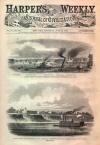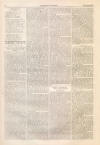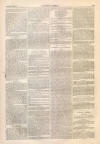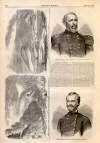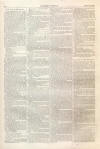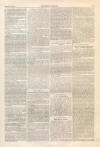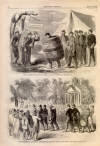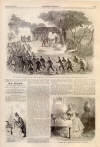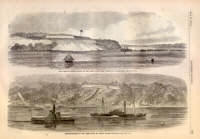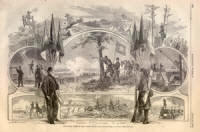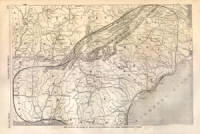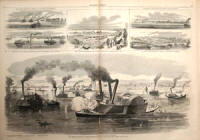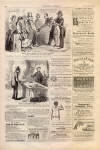Battle of Front Royal
|
|
This Site:
|
JUNE 28, 1862.] HARPER'S WEEKLY. 411 (Previous Page) movements from the Mound, observed one of them—which one could not be ascertained—run rapidly to the Arkansas shore. Reaching it, she paused, and a moment afterward flames were discovered issuing from her upper deck. She had evidently been permanently disabled by the enemy's fire, and abandoned and fired by her officers and crew. The pursuit still continued to the foot of President's Island as far as the eye could reach, the gun-boats rapidly firing as they went, a shot occasionally being returned from our fleet. In a short time two of the Federal iron-clad boats were observed steaming back, accompanied by the Monarch. The conclusion arrived at was that the remainder of our fleet had met the fate of the others. The loss of life in this engagement can not yet be estimated with any degree of accuracy. The cannonading, we presume, killed few, but a number are known to have fallen by the enemy's sharp-shooters. Whenever the contending boats came together, rapid reports of guns and pistols could be distinctly heard front the shore. It is supposed that quite a number went down with the sinking vessels. The loss of the enemy, other than the damage to the ram, has not been ascertained. His boats were altogether superior to ours in every respect, and therefore sustained small loss, save in hand-to-hand encounters. The following account of forts Wright and Pillow, and of the descent of the Mississippi by the flotilla under Commodore Davis, is from the Herald correspondence: Fort Pillow is situated on the First Chickasaw bluffs, on the Tennessee shore of the Mississippi River, about seventy miles above Memphis. The course of the bluffs is nearly north and south, and above them the river makes a bend nearly at right angles to the bluff, the upper end of the latter being just at the termination of the bend. At this point a small stream, known as Coal Creek, enters the Mississippi, separating the bluff from the bottom land beyond. On Thursday morning orders were issued for the gun-boats and rams to get under way and move down to the now deserted fort. The rams Switzerland and Monarch got in motion before the more ponderous gun-boats could swing front their moorings, and steamed slowly poet Craighead Point and outward toward the frowning cliff in their front. All eyes were strained to perceive if possible any sign of human occupation: but the bluff was as tenantless as when Ferdinand de Soto discovered that great river. The landing was soon reached, and a party of soldiers springing on shore climbed the parapet of the works, and unfurled the Union flag for the first time from Fort Pillow. A cheer rose from the advancing gun-boats and transports, and in a short time the rebel fortifications were alive with Union soldiers. Fort Pillow is by far the strongest position yet selected on the river for rebel batteries. The bluff rises abruptly from the stream about a hundred feet, and at all points is very difficult of ascent except where artificial means are used. Along its base for nearly three-fourths of a mile strong works have been constructed about twenty feet above the level of the river. The glacis is at the highest possible angle for earth to be placed, and can now only be ascended in places where the men have dug small steps or foot-holes. At regular intervals along the whole distance the work is properly bastioned, most of the bastions being built of sand-bags, planking, and rammed clay. Some of them are designed for mounting two guns, but most of them for but one All of the guns were protected by embrasures, though none of them were casemated. The walls of the embrasures are constructed in the strongest manner possible, one of them, and in fact the entire bastion, being of granite, chiseled and built up with great care and nicety. The guns were mounted on first plank floorings, and commanded the entire river between the fort and Craighead Point. The batteries are built on a bench at the base of the cliff, upward of half a mile in length by fifty yards in width. Several springs gush from the base of the bluff, which rises abruptly, like a wall of granite, and afford clear water to the men within the fort. Four bomb-proof and well-constructed magazines are placed at intervals in rear of the batteries, in the least-exposed positions. Near some of the guns were holes in which the men could retire whenever threatened with bursting shells —probably an imitation of the famous "rat-holes" of General Bragg at the batteries in front of Fort Pickens. On the summit of the bluff commences a series of extensive field-works, extending in the aggregate from five to seven miles, and all provided with a ditch in front that could only be leaped by an agile man. After a few hours at Fort Pillow the boats moved on down the river, where the retreating craft of the enemy had disappeared but a few hours in advance. The evacuation of the fort was begun on Sunday, but the final departure of troops did not take place till Wednesday, when they left on their transports. On the way down one of our transports laden with troops saw something suspicious at Fulton, two miles below Fort Pillow. On landing she found two twenty-four-pound siege guns loaded with a double charge of grape, and pointed to sweep the river. The carriages were complete, and the two guns were quietly taken on board. Randolph, on the second Chickasaw bluff, at the mouth of the Hatchie, ten miles below Fort Pillow, was evacuated on Tuesday, the commanding officer, Com. Pinckney, saying that, as he was lame, he would like to get a good start. At Fort Randolph are seven disabled guns and a pile of burning cotton. On the summit of the bluff are extensive field-works, similar to those at Fort Pillow, most of them erected in 1861, and evidently designed for resisting a land attack. In a long subterranean passage were several openings to the surface, at one of which your correspondent found several soldiers grouped, greatly amused at the echo of their voices as they shouted down the aperture. Fort Randolph is a strong natural position, but was of no importance to the rebels, Fort Pillow being evacuated. It is the first point on the Mississippi that was fortified after the outbreak of the rebellion, some of the works being constructed more than a year since. It is the first high ground above Memphis, sixty-five miles below, all the intervening country being low bottom-land and swamps, liable to overflow during the period of floods on the Mississippi. On page 401 we give another picture of the FIGHT AT MEMPHIS, during the closing scene of the affair; and on the same page a picture of the UNION RAM LANDING AT MEMPHIS to demand the surrender of the city. Colonel Eller, commanding the Ram fleet, thus described the affair: Yesterday, after the engagement with the rebel fleet had nearly terminated, and the gun-boats and one of my rams had passed below, I was informed that a white flag had been raised in the city. I immediately sent my son, a medical cadet, Charles R. Ellet, ashore with a flag of truce, and the following note to the authorities: OPPOSITE MEMPHIS, June 6, 1862. I understand that the City of Memphis has surrendered. I therefore send my son with two United States flags, with instructions to raise one upon the Custom-house and the other upon the Court-house, as evidence of the return of your city to the care and protection of the Constitution. CHARLES ELLET, Jun., Colonel Commanding. The bearer of the flag and the above note was accompanied by Lieutenant Crankell, of the Fifty-ninth Illinois Regiment, and two men of the boat guard. The following is the reply of the Mayor of the city: MEMPHIS, June 6, 1862. Colonel Charles Ellet, Jun., Commanding, etc.: SIR,—Your note of this date is received and the contents noted. The civil authorities of this city are not advised of its surrender to the forces of the United States Government, and our reply to you is simply to state respectfully that we have no forces to oppose the raising of the flags you have directed to be raised over the Custom-house and Post-office. Respectfully, JOHN PARK, Mayor. On receiving this reply, the small party proceeded to the Post-office to raise the national flag, and was there joined by the Mayor. It is proper to say that the conduct of the Mayor and some of the citizens was unexceptionable; but the party was surrounded by an excited crowd, using angry and threatening language. They ascended to the top of the Post-office and planted the flag, though fired upon several times and stoned by the mob below. Still I believe this conduct was reprobated by the people of standing in the place. Indeed, many evidences of an extensive Union sentiment in the place reach me. GENERAL HEINTZELMAN.BRIGADIER-GENERAL SAMUEL P. HEINTZELMAN, whose portrait we publish on page 404, was born in Pennsylvania about the year 1806, and is consequently about fifty-six years of age. He entered the army from West Point in 1826. During the Florida war he, as Quarter-master, disbursed $3,000,000, without the loss of a dollar to the Government. During the early part of the Mexican war he was detailed to muster in volunteers on the Ohio and Mississippi rivers. After repeated applications he was relieved from that duty, and reported to the commander at Vera Cruz, where he organized a battalion of recruits and convalescent soldiers, and took up his march for the city of Mexico. He had several engagements with the enemy —a severe one at Huamatta, where Major Walker, of the Texas Rangers, was killed; for this engagement he was brevetted. At the close of the war Major Heintzelman was ordered with his regiment to California. He was ordered to the command of the southern district of California, where he remained about five years, having during that time established Fort Yuma, and made a personal reconnoissance of some two hundred miles of the Colorado River. He put the first steamer on the Colorado River. During the time he was in command of this district the numerous tribes of Indians in that neighborhood became hostile, and commenced murdering and plundering the emigrants, who were taking the great Southern route to California. Major Heintzelman was charged with the suppression of these hostilities. That he did it to his own credit and the satisfaction of his Government the following extract from the report of General Hitchcock will show: "The General commanding congratulates you and the officers of your command on the termination of the Indian war in the south. To your good judgment and untiring energy and perseverance the country are under many obligations for its successful termination." During the season of 1859 Major H. was ordered to take command of an expedition to protect the southern borders of Texas against marauding parties instigated by the well-known guerrilla chief, Cortinas. That he performed this duty satisfactorily is vouched for by an extract from General Scott's indorsement on his report of the affair to the War Department: "This is the report of a brilliant affair in which Major Heintzelman distinguished himself, as he has done many times years before. I beg to ask a brevet for him in small part to compensate for the injustice done him by the War Department." Major Heintzelman left Texas a few weeks previous to the treachery of Twiggs. Soon after his arrival, although "on leave," he was put on duty as Inspector-General at Washington. On the 14th of May his commission was renewed as Brevet Lieutenant-Colonel, "for service in an Indian campaign in 1851," and on the 27th day of May he was appointed Colonel of the 17th Infantry, and ordered to the command of a brigade consisting of four regiments of volunteers, with several companies of regular cavalry and artillery, at Alexandria. He was subsequently appointed to the command of the 3d Division of the army of the Potomac under General McDowell. At Bull Run he distinguished himself and was severely wounded, but was among the last to leave the field. On the division of the Army of the Potomac into army corps under General McClellan, General Heintzelman obtained command of one of the new corps, and led it with McClellan toward Richmond. It was this corps which suffered most at the terrible battle of Fairoaks. Their performance on that occasion reflects the highest credit on General Heintzelman. He has taken his place among the heroes of the day. THE BATTLE AT FRONT ROYAL.ON page 404 we publish a view of FRONT ROYAL, VIRGINIA, and another of the FIELD IN WHICH COLONEL KENLY SUFFERED SO SEVERELY ON 23D ULT. Both are from sketches by an officer who since visited Front Royal. Major-General Banks, in his official report of the affair, says: Front Royal is in itself an indefensible position. Two mountain valleys debouch suddenly upon the town from the south, commanding it by almost inaccessible hills; and it is at the same time exposed to flank movements by other mountain valleys, via Strasburg on the west and Chester Gap on the east. The only practicable defense of this town would be by a force sufficiently strong to hold these mountain passes some miles in advance. Such forces were not at my disposal, and no such expectations were entertained from the slender command of Colonel Kenly. It was a guerrilla force and not an organized and well-appointed army that he was prepared to meet. On the 23d of May it was discovered that the whole force of the enemy was in movement down the valley of the Shenandoah, between the Massanutten Mountain and the Blue Ridge, and in close proximity to the town. Their cavalry bad captured a considerable number of our pickets before the alarm was given. The little band which was charged with the protection of the railroad and bridges found itself instantaneously compelled to choose between an immediate retreat or a contest with the enemy against overwhelming numbers. Colonel Kenly was not the man to avoid a contest, at whatever odds. He immediately drew up his troops in the order he had contemplated in case of attack of less importance. The disposition of his forces had been wisely made to resist a force equal to his own, and the best, perhaps, that could have been devised in his more pressing emergency. About one o'clock P.M. the alarm was given that the enemy was advancing on the town in force. The infantry companies were drawn up in line of battle about half a mile in the rear of the town. Five companies were detailed to support the artillery, which was placed on the crest of a hill commanding a meadow of some extent, over which the enemy must pass to reach the bridges—one company guarding the regimental camp, nearer to the river, on the right of the line. The companies, three in number, left to guard the town, were soon compelled to fall back upon the main force. There were then four companies on the right of the battery near the camp, under Lieutenant-Colonel Dushane, and five companies on the left under Colonel Kenly. The battery, Lieutenant Atwell commanding, opened fire upon the enemy advancing from the hills on the right and left, well supported by the infantry, doing much damage. A detachment of the Fifth New York cavalry was ordered to advance upon the road, which was attempted, but did not succeed. They held this position for an hour, when they were compelled to retreat across the river, which was done in good order, their camp and stores having been first destroyed. On the opposite side their lines were again formed, and the battery, in position, opened its fire upon the enemy while fording the river. They were again ordered to move, left in front, on the Winchester road, and had proceeded about two miles when they were overtaken by the enemy's cavalry, and a fearful fight ensued, which ended in the complete destruction of the command. Colonel Kenly, at the head of his column, was wounded in this action. The train and one gun were captured. One gun was brought within five miles of Winchester, and abandoned by Lieutenant Atwell only when his horses were broken down. The enemy's force is estimated at eight thousand. The fighting was mostly done by the cavalry on the side of the rebels, with active support from the infantry and artillery. Our own force did not exceed nine hundred men. They held their ground manfully, yielding only to the irresistible power of overwhelming numbers. Prisoners captured since the affair represent that our troops fought with great valor, and that the losses of the enemy were large. A prisoner captured near Martinsburg, who was in the Front Royal army, states that twenty-five men were killed in the charge on the Buckton station. Six companies of cavalry charged upon our troops at that place. The killed and wounded numbered forty odd. Among the killed were Captain Sheats and Captain Fletcher. The name of the prisoner is John Sayer. It is impossible at this time to give a detailed account of our losses. Reports from the officers of the regiment represent that but eight commissioned officers and one hundred and twenty men have reported. Of these officers five were in the engagement, two absent on detached service, and one on furlough. All the regimental officers were captured. Colonel Kenly, who was represented to have been killed, is now understood to be held a prisoner. He is severely wounded. Lieutenant Atwell reports that of thirty-eight men attached to his battery but twelve have reported. The cavalry was more fortunate, and suffered comparatively little loss. Undoubtedly large numbers of the command will yet return, but it is impossible to speculate upon the number. OUR FLEET IN THE JAMES RIVER.WE devote page 405 to illustrations of the operations of OUR FLEET IN THE JAMES RIVER. One of our pictures represents Fort Darling, which was lately attacked by Commander Rodgers with the Galena, Monitor, and other vessels. A letter from one of the ships engaged said: At 8 A.M. we came in sight of the battery called Fort Darling, situated just beyond a sharp turn in the river, and about one hundred and fifty feet above it. Just abreast of it the wrecks of several vessels could be seen, completely blocking up the channel. These are said to be the Jamestown, Yorktown, Teaser, Patrick Henry, Curtis Pack, and Northampton, besides several scows and schooners. The fleet now approached in the following order: The Galena, Monitor, Aroostook, Port Royal, Stevens Battery. The river was here very narrow, and the channel did not exceed sixty yards in width, and was quite intricate. The vessels, therefore, could not shift positions readily, but were obliged to come to anchor and work from springs on their cables. After describing the fight, with the details of which our readers are familiar, he adds: Too much praise can not be given to Commander Rodgers and the other officers of the expedition for the gallant manner in which the boats were handled, and for the rapidity and accuracy of their fire, exposed as they were at anchor in a narrow channel to a heavy plunging fire from a casemated battery, and of musketry from the banks. The narrowness and shallow water of the channel, and the close range at which the gun-boats lay—being only from 600 to 1000 yards from the battery—made it one of the most brilliant actions of the war, and the small loss sustained is very surprising. Of the reconnoissance the author of the sketch which we reproduce says: On the morning of Friday, May 30, the United States steamers Mahaska, Captain N. B. Harrison, and Jacob Bell, Captain E. P. M'Rea, ran down the river from the rendezvous at City Point, about eighteen miles, to take and spike the guns of the battery at Fort Powhatan. Having arrived in position, an armed boat, with a small detachment of marines, was sent ashore from the Mahaska, followed by another from the Bell; but the party, after scaling the bank, which is here about thirty feet high, found the works had a few days before been deserted. The battery is partially concealed behind a large wood-pile on the top of the bank. At the foot, nearer the river, is seen the remains of Fort Powhatan, a Revolutionary ruin of no little interest. CAMP PUNISHMENTS.ON page 412 we illustrate two of the punishments adopted in our army. One of the pictures represents the DRUMMING OUT OF A COWARD FROM GENERAL BURNSIDE'S ARMY. The fellow was marched through the lines between a file of soldiers, with his head cropped, and a large placard "coward" affixed to his back, while the band played the "Rogue's March." The other picture represents one of the punishments for drunkenness adopted in General Halleck's Army of the Mississippi. The drunkard is made to get into a barrel. which is so suspended that his head and his feet project, and locomotion, if not agreeable, is not impossible. The barrel is labeled, "Too fond of whisky." Thus accoutred, the miserable fellow is the butt of the scoffs and jeers of his comrades for a day, and learns a lesson which ought to teach him the virtue of temperance for the rest of his life. THE SIGNAL CORPS.THE sketches on page 406 will be particularly interesting at this time, when so much is heard of the Signal Corps. Major Myer, the Signal Officer of the Army and Chief of the Corps, was appointed from New York State, and entered the army in 1854. For many years he has worked in maturing his system, now the most complete ever organized; and when he received his commission as Major, indorsed by the highest military talent, and with authority to organize and instruct a class in the new code, it is a noticeable fact that his appointment was violently opposed by Jeff Davis. With the means now at his disposal, Major Myer can have an uninterrupted line of signals established from the blockade of the Potomac to the extreme right of the army in six hours, each telescope sweeping the field of vision of those on the adjacent stations. There are now signal officers detailed to the armies in Kentucky, in South Carolina, and with Burnside in North Carolina, and a party will soon be sent to the expeditions on the Mississippi. To prevent such accidents as have occurred by our troops firing into each other, Major Myer should, without a day's delay, be provided with the means of introducing the countersign signals throughout the whole army. The value and necessity of this system has been fully demonstrated in official reports. The centre picture of the engraving represents an officer, accompanied by his flagman, at his station on the field of battle, his telescope slung to a tree for steadiness, and a star instead of a square on his flag, denoting that it has already been carried under fire in a manner to receive honorable mention for service on the battle-field. On the left is a party using torch signals. To the right, signaling at sea. Above, an officer is represented who has climbed a tree, by the assistance of a lariat, to get above the neighboring woods for observation. In the centre is a signal officer reconnoitring with his glass, his flag kept working out of sight of the enemy; and on the left platforms erected in trees to form a station. In the lower compartments an officer standing on a limber to get a view over the line of men moving at the double quick; a party running the gauntlet of the enemy's skirmishers to take up a position, and another party signaling on horseback, the large figures representing signalmen equipped and prepared to go upon duty. In making these sketches I have received valuable assistance from Lieutenant N. Daniels, signal officer, for whose courtesy I here tender my acknowledgments. WAUD. THE BATTLE AT TRANTER'S CREEK, NORTH CAROLINA.Oust artist with General Burnside's expedition has sent us a sketch of the recent BATTLE AT TRANTER'S CREEK, fought on June 5; we reproduce it on page 413. The enemy it seems had been gathering in some force in the neighborhood of Washington, North Carolina, and after awaiting an attack for some time, our officers determined to assume the offensive. The Herald correspondent thus tells the story: On Thursday morning, June 5, a reconnoissance in force started from here (Washington) under command of Lieutenant-Colonel Osborn, commanding the Twenty-fourth Massachusetts regiment, accompanied by Colonel Potter of the First North Carolina Union Volunteers, and Lieutenants Strong and Pendleton, the two latter officers acting as aids. The expedition consisted of the Twenty-fourth Massachusetts regiment, Company I of the Third New York cavalry, under command of Captain Jocknick and Lieutenant Allis, and a detachment from Colonel Howard's Marine Artillery, under command of Lieutenant Avery. The infantry and artillery, having taken up the line of march, formed a junction with the cavalry on the outskirts of the town, when all advanced along the Greenville road, while the gun-boat Picket, Captain Nichols, proceeded up Tar River and shelled the woods ahead. After marching some distance, a sight of the enemy was at length obtained. The same correspondent writes: Its order to understand the progress of the fight, it may be well to here give a brief description of the vicinity. The road, near where it crosses the bridge, descends through a ravine or gorge, and, turning suddenly to the left, skims along by the edge of the creek, which at this point is more properly a wide pond or swamp, filled with stumps of trees. On the bridge are a saw-mill and cotton gin, whose power is derived from the flowing of the water. The rebels had taken up the boards of the bridge between the two buildings, and with them constructed it breast-work, if it might be so called, near the cotton gin. The column at length got in motion again from the widow's house, and the skirmishers, having descended the ravine, cautiously moved toward the bridge. The advance-guard was from Company A, and under command of Lieutenant Jarvis. Coming from under cover of the trees, they moved up the inclined plane at the foot of the bridge, and suddenly discovered a row of heads behind the breast-work of boards, and the guns all leveled toward them. Sergeant Shepard and a companion fired, and a heavy volley came in return. Lieutenant Jarvis fell at the first fire. The rest of the advance returned the volley, and then fell back on the main body. Colonel Osborn immediately ordered forward the artillery, and in less time than it takes to narrate it the gallant marines, under Lieutenant Avery, came dashing down the hill with their guns, which they stationed, one bearing on the enemy's front through the arch of the saw-mill, the other to the left of the bridge, and raking the enemy on their right flank. The main body of the infantry also came forward on the double-quick, while Captain Jocknick formed his cavalry on the brow of the hill, ready to charge the enemy at the decisive moment, though, as it afterward happened, no opportunity was afforded to his men to strike a blow, owing to the nature of the affair. On account of the narrowness of the road, only three companies of the infantry could be brought into action at once, and the rest were disposed of in the rear, where they were ordered to lie down. With one company in the road, and one on either side, the engagement regularly opened on our side. Lieutenant Avery discharged several rounds of shell and canister at the enemy's position; for they were so concealed in the bridge and behind the trees as to be completely out of sight. The infantry poured a terrific fire across and on either side of the bridge, the riddled beams and posts of which soon gave token of the showers of balls which were passing and re-passing. A number of rebels had secreted themselves in the left of the cotton gin, and were firing very briskly when driven out by a shell which Lieutenant Avery lodged in the building. Others again were discovered ensconced in the tree-tops on the opposite side of the creek. Lieutenant Avery elevated his pieces, and fired a couple of rounds of canister through the branches, whereupon several bodies were seen to fall to the ground, at sight of which our boys burst into a prolonged cheer or yell. The steady firing of the artillery and the volleys from the Twenty-fourth at length drove the rebels from the bridge, and, falling back, they kept up a desultory fire from the trees and the edge of the creek. At length the word was given to charge. The artillery fired a round to clear the way, and, under cover of the smoke and the effects of the canister, our boys with fixed bayonets dashed upon the bridge, and, headed by Colonel Potter, advanced on a run to the point where the boards had been taken up. Replacing them as best they could, they passed over, and found themselves undisputed occupants of the field; for the rebels had fled down the creek and through the woods, leaving behind them three of their dead and a large quantity of muskets, shot-guns, swords, sabres, and other weapons. Their rout was thorough and complete. The ground was covered with pools of blood, showing that their loss was pretty heavy, though it is impossible to ascertain the exact figures, as they carried off all their dead and wounded except the three bodies above referred to, which they could not rescue owing to the heavy fire of our artillery on the spot where they were lying. At the opposite side of the bridge the rebels had thrown up a temporary breast-work of cotton bales in an angular shape, with the corner nearest the approach from the bridge; but it failed to serve them as a means of defense. Our loss on the battle-field was four killed and twelve wounded; but three of the latter died soon after the fight, so that our loss now stands seven killed and nine wounded. |
||||||||||||||||||||||||||||||
|
|
||
|
|
Site Copyright 2003-2018 Son of the South. For Questions or comments about this collection, contact paul@sonofthesouth.net |
|
|
Are you Scared and Confused? Read My Snake Story, a story of hope and encouragement, to help you face your fears. |
||
